27
In this earlier picture, at a Hayman milling site, no 'plank edger' is in existence. It was important to remove the accumulating sawdust, and wheelbarrows carried it to a pile where it eventually became fuel for the furnace. These sawdust mounds can still occasionally be seen in derelict mill sites.There was a 'pecking order' when it came to jobs on the sawmill site. Collecting sawdust and filling wheelbarrows was not high on the list, but it was an essential task.
There was little in the way of entertainment for the men when work finished, but usually there was someone who could play the fiddle, and provide lively tunes to tap ones feet to or sing along.
28
Hayman Steam Sawmill, North Shore, Nova Scotia, Canada1915
North Shore, Nova Scotia, Canada
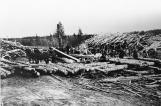 Credits:
Credits:North Shore Archives CSHC
29
Russell Hayman (brother of Frank and Henry) and his family owned one of such mills; he was in a partnership with his older brothers. At the age of 14 he started shovelling sawdust, then moved to carrying slabs from off the logs, edging, canting, turning the logs, and then to sawing, the top job. The pile on the right hand side was used as fuel for the engine. The machine on the right is an early 'edger' which trimmed the rough sides off the plank.Mostly the sawing was done in the winter, and the engine was taken to a site in the woods. The men would make a temporary campsite and once they had cleared one area, they would move on about 20 miles. The mill, the camp, and the logs were transported through the woods with wagons and sleds. The boiler itself weighed five tons and it took eight horses to move it.
30
Byers Gristmill Dam, New Annan, Nova Scotia, CanadaLate 1800s/ Early 1900s
Byers Brook, Nova Scotia, Canada
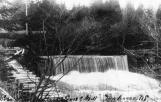 Credits:
Credits:North Shore Archives CSHC
31
The dam at Byers Brook seems to have supplied a number of mills, including a drying kiln for oats. Around the turn of the century, there is a story that a neighbour saw a fire in the kiln and ran to give warning, but a bad stutter prevented him from giving the alarm. Finally someone remembered that he could sing well without stuttering, so he sang the warning, but too late to save the kiln.1825 saw William Byers starting a grist mill to produce flour, and a year later a machine was added to make oatmeal.
32
Riverside Mill, New Annan, Nova Scotia, Canada1890
Byers Brook, Nova Scotia, Canada
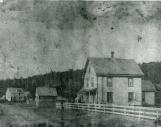 Credits:
Credits:North Shore Archives CSHC
33
A dam was built across the river, on Byers Brook above the rotary sawmill, and the water was diverted by means of a sluiceway cut in the rock from there to the mill site.The Riverside grist mill was located on the east side of Byers Brook, above the site of the local church. There was a rotary sawmill just upstream.
E.K.Johnson had a carding mill from the 1850's, taking in wool from the local farmers. His son, Harry, took over the business in 1906 and added a shingle mill as well as machinery for fulling and weaving cloth- the operation was still functioning in 1926. There were separate buildings for dyeing cloth, they contained large copper vats; it is said that Johnson used one as a bathtub when he quit the manufacturing of cloth. Water to power all this came from a channel dug in from the river, which could be closed off by a gate at the upper end as required.
A story has it that Charles Stanfield (of clothing manufacturing fame) learned the carding process through working for Johnson, but Stanfields feel it was the other way around (The first Stanfield Woollen mill was established in 1870).
Edward Johnson probably learned his trade working at the Geddes mill, still owned at that time by William Byers. The carding mill ran until the mid 1920's; on closing the materials were recycled and a tannery was established, run by Eugene Swan near his home in Central New Annan.
Another carding mill was opened on the Waugh's River in Balfron and in 1882, James Matheson started a woollen mill. Unlike today, sheep were kept in large numbers, so wool was available.
According to an old newspaper, date unknown, subscribers went to considerable expense putting in the machinery for the manufacturing of tweeds and yarns. Wool would be taken in exchange for cloth and yarn. His son joined him in the business and it was running until 1907. In 1905, they were involved in an actual clothing manufacturing business.
(An Alex Ross was peddling in cloth in 1897, and perhaps some came from the woollen mill.)
At Earltown, John MacKay (son of Alex MacKay Sr., who operated the Balmoral Gristmill) opened a small carding mill in the 1820s. He had the minimum of equipment but it served the local community until replaced by larger mills at Welsford and River John.
34
Site of Carding Mill at Byers Brook, New Annan, Nova Scotia, Canada3 July 2010
Byers Brook, Nova Scotia, Canada
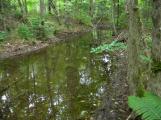 Credits:
Credits:S. Brinkhurst
35
The remains of the flume/spillway that once brought water to the various mills on the Riverside property. The entire area is overgrown and nothing else remains.36
Balmoral Gristmill, Balmoral, Nova Scotia, Canada1900
Balmoral, Nova Scotia, Canada
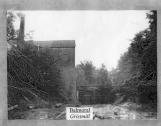 Credits:
Credits:North Shore Archives CSHC
37
During the last half century there were several mills along the Matheson Brook. In 1854, Alexander MacKay, who learned the milling trade from his father in Earltown, was thought to be operating a sawmill and gristmill on Matheson Brook, at Balmoral. This was a short distance above the present mill location.In 1874 he built the existing grist mill; it was an ideal site, with a growing community of Highland Scots amongst whom was the prospect of finding a wife!
Arthur Treen of Malagash, writing in 1985 about events during the previous 90 years, recalls one winter that was so cold they were able to travel on the ice up the Waugh's River to McKays's Gristmill at Balfron to get the grain ground.
There were various places to go to get grain milled according to the time of year: Swans's in New Annan, Howard's at Wallace River and Dewar's in Malagash; this latter was only 7 miles from where the Treen's lived and therefore the handiest! But it was often closed because of lack of water in the summer or another mill damming off the water above the Dewar mill. Several trips might be made in a year to get the grain ground.
38
Balmoral Gristmill Today, Balmoral, Nova Scotia, Canada6 August 2010
Balmoral, Nova Scotia, Canada
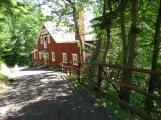 Credits:
Credits:Nova Scotia Provincial Museum
39
Balmoral Gristmill today, where grain is still milled and it is possible to buy fine oatmeal.It was fairly common for gristmills and sawmills to be in the same building but this was inefficient, and there was always a risk of fire. Alexander McKay wanted a separate gristmill, so in 1873 he purchased land a little further downstream for $12. Construction of the mill started immediately, with the help of his brother John, who had taken over their father's mill in Earltown.
Lumber for the grist mill was sawn at the upstream sawmill, which was sold in 1883 to the Sutherland Brothers, Alexander and James. It burned down in 1886.
Alexander McKay continued to operate the mill until his son Hugh was sufficiently experienced to take on the task of assistant miller. When Alexander died in 1886, Hugh kept the mill operational until 1904, when he sold it a former apprentice, Alexander. L .MacDonald. Under him and his son, the mill continued until 1954, when it closed. A period of deterioration followed until eventually after efforts were made to preserve the mill, it came into the hands of the Nova Scotia Provincial Museum. It is now an attractive tourist destination.
Gristmills in the Earltown Area
Howard Cavanagh built a grist mill on the North River, a little beyond our area, where a narrow carriage path led to the mill on Cavanagh's Hill. Operations ceased in 1914.
James McKay (Big Jim) built a grist mill on Nabiscump Brook, McBain's Corner (East Earltown) in 1895. His son (Long Jack) helped him run the establishment on the home farm, until a fire in 1900 destroyed everything, and the insurance did not cover the loss. The site was abandoned and 'Long Jack' moved to Western Canada.
William McKay had a mill on Fergusons Brook, which flowed into the Waugh's River. The brook ran across his property.
William Murray appears to have been operating a mill in 1834 to help Earltown and Tatamagouche, as there was no mill within 8 miles. He applied for help from the House of Assembly in Halifax for funds to build it, successfully it seems, as an experienced workman Jes. Redrick was engaged to build the mill.
It is possible that Murray belonged to the New Annan settlement.
40
Area Showing Industries, Wallace, Nova Scotia, Canada1800 - 1900
Wallace, Nova Scotia, Canada
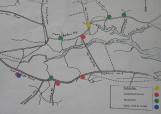 Credits:
Credits:North Shore Archives CSHC
S.Brinkhurst
H. R. Brown